Warszawa II (18 page)
Authors: Norbert Bacyk

The picture below shows a Polish T-34-76, model 1943, with infantry aboard. The picture above shows a knocked out Panther tank from the “Herman-Göring” Division after the battle. All told the German side lost thirty tanks in the battle. The lower picture on the facing page shows another Polish T-34-76 model 1943. The Russians lost some thirty tanks in the battle. The picture above shows a T-34-85 from the reinforced 164th Tank Brigade despatched by the 16th Tank Corps which arrived two days after the battle. (All photos: Leandoer & Ekholm Archive)
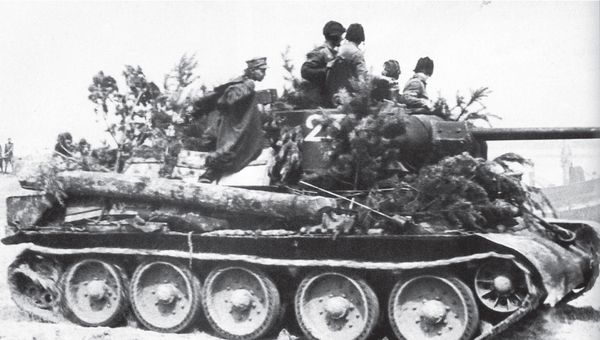
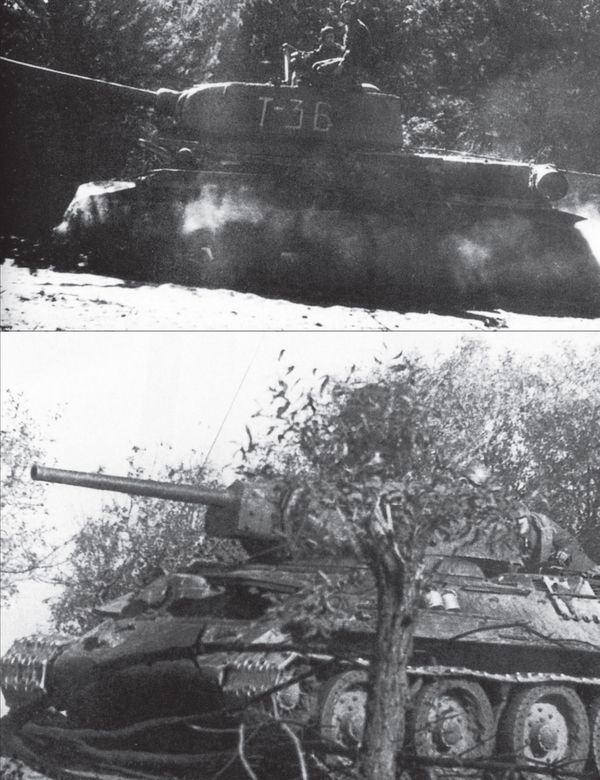
All attempts to pierce the defence were immediately met with counterattacks by improvised Kampfgruppe from the 5th SS-Panzer-Division “Wiking” and the 3rd SS-Panzer-Division “Totenkopf ”. Tanks wound up in long-distance artillery duels in which the Soviet side proved to be without chance. This was the case because the warring Soviet infantry's main support came from outdated, model “Valentine” tanks, while their modern tanks had been placed in other armoured entities, as for example, in Guards units. In addition, the relatively few German tanks and tracked assault-guns, fought from ambush positions in the forest where they were at least camouflaged from the ever present threat of the IÅ-2's bombers.
A more difficult situation for the IV SS-Panzer-Corps had developed, instead, around WoÅomin itself. After the enemy had reached the nearby village, Nadma, the German troops occupying Wololmin were fighting half-encircled and only had contact with the corps along the railway line to Zielonka. Finally, subsequent to the 129th Rifle Corps ending its assault of WoÅomin; the situation became temporarily stabilised. Despite this, and with the aim of improving his troops' situation, Gille received permission to shorten the defender's line. On September 6, the German and Hungarian troops left WoÅomin and withdrew to the suburbs of Zielonka. This was the final clever feint in the new Soviet offensive phase of the war which had begun on August 10. Beginning on September 3, SS-Gruppenführer Gille's frontline troops experienced a welcome period of relative calm.
However, the intense fighting having let up against the frontline at Warsaw did not mean that the crisis in Heeresgruppe “Mitte's” sector was over. The German forces defending Praga's suburbs were extremely weak. General von Vormann had quite correctly foreseen that the Soviets side's aim was to renew carrying out its assault strategy as soon as possible, particularly in the direction of Warsaw. Therefore he sent reminders to von dem Bach and General Hans Schirmer, (Schirmer had replaced General Stahel as commandant of urban warfare on August 25, who was dispatched in all haste to Bucharest) concerning the quashing of the Uprising and protecting the bridges across the WisÅa and along Warsaw's left river bank. He then presented these concerns in very striking terms to the 9th Army's chief of staff, General Städke â and in a telephone conversation to von dem Bach, he stated that: “Not a single tank shall be allowed to pass!”
At the same time, the 9th Army, which had been burdened with the responsibility of defending the middle section of the Wisla, was suddenly weakened â because now it was General WeiÃ's 2nd Army, fighting in the northern zone, that began the final retreat over the Narew and, among other locations, withdrew from Wyszków. Weià reported: “During that day the situation became so grave that the order was given directing the XX and XXIII Army-Corps to withdraw to the other side of the Narew and the EastPrussian defence line.” But the 48th Army, the 65th Army, and the 1st Guards Tank Corps, all components of the 1st Belorussian Front's right flank, succeeded in reaching the Narew at several points parallel to the retreat of the Germans and set up strong bridgeheads on its western bank. The 28th Army, positioned on the Bug's southern bank where it ran out close to Wyszków, was also active here. The 128th Rifle Corps from this army pursued the XX Army-Corps and crossed over the Narew by Wierzbica, two kilometres north of Serock. The Soviet troops also seized the important bridgehead at Różan (the 48th Army) and at PuÅtusk (the 65th Army with the 1st Guards Tank Corps).
Two T-34-76's crossing the Vistula by ferry in August 1944. They are en route to a newly established bridgehead, south of Warsaw. Note the Willy's jeep on top of the tank. It was all about efficency! (Leandoer & Ekholm archive)
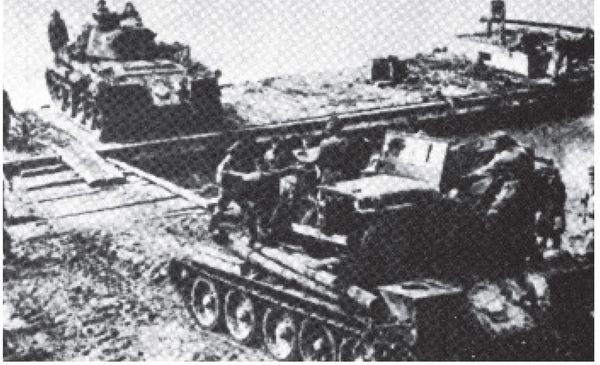
This course of events caused General Reinhardt, as soon as the temporarily stabilised situation outside of Praga was made known to him by von Vormann , to decide in favour of strengthening the 2nd Army at the expense of the 9th Army. He rescinded the order he had given two days earlier concerning the redeployment of the new 542nd Grenadier-Division to Warsaw, and despatched it instead to the area around PuÅtusk, where it was to operate together with the 35th Infantry-Division and the Panzer-Abteilung 104.
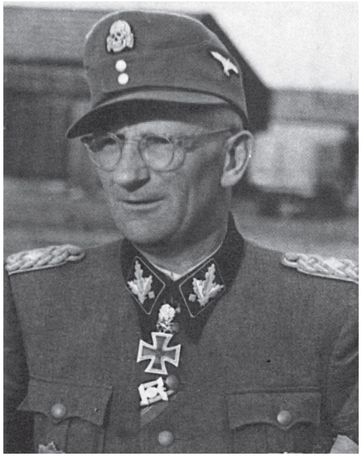
The commander of the 5th SS-Panzer-Division “Wiking“ (later the IV SS-Panzer-Corps) SS-Gruppenführer Herbert Otto Gille. (Leandoer & Ekholm archive)
Katyusha BM 13-16s carrying out a bombardment outside Praga in August 1944.(Leandoer & Ekholm archive)

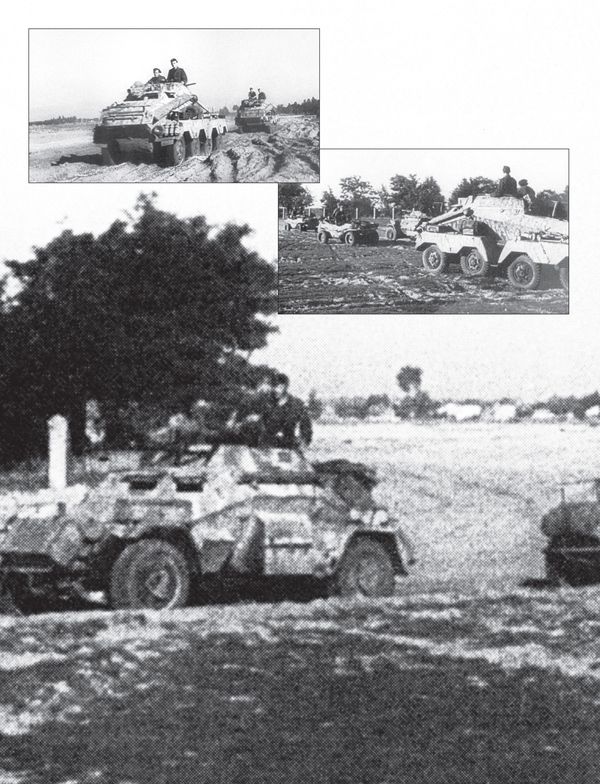
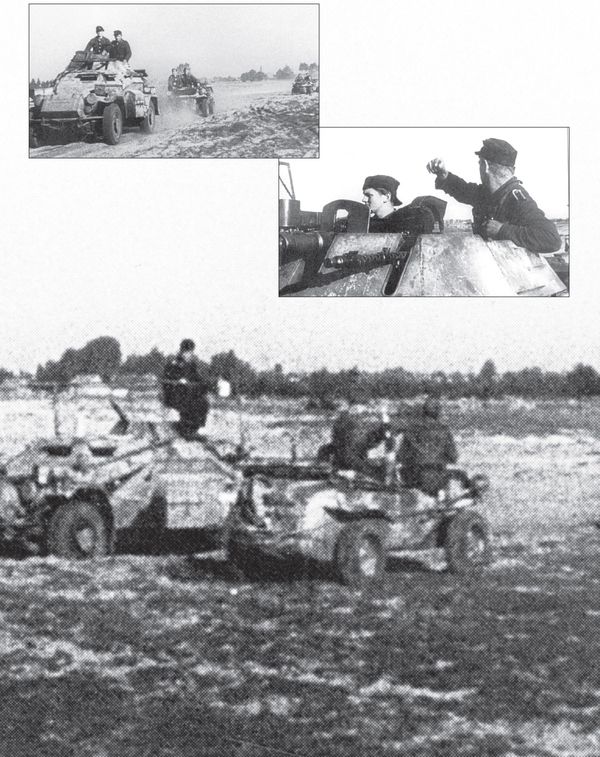
These five pictures show parts of a reconnaissance battalion from the 19th Panzer-Division, northeast of Warsaw at the turn of August-September 1944. The following vehicles are visible: Schwimmwagen.German amphibious jeep, Sd Kfz 222- German 4x4 armoured car, Sd Kfz 261 â a 222 equipped with a stronger radio and a Sd Kfz 233 7.5cm L/24 â an 8x8 heavy armoured car equipped with a short-barrel 7.5 cm gun capable of taking on both tanks and infantry. (Leandoer & Ekholm archive)
Thereafter, he further strengthened this formation with the 1131st Grenadier-Brigade that had been pulled away from its co-operation with the 3rd SS-Panzer-Division “Totenkopf” and the Panzergrenadier-Regiment 73 which had been assigned to the 5th SS-Panzer-Division “Wiking.” Over the course of two days, he even decided to commit the rest of the SS-Panzer-Regiment 5 to the stretch between Serock and PuÅtusk. Meanwhile, in accord with decisions made by the OKW and OKH, the commander of Heeresgruppe “Mitte” was, at the same time, expecting that the 24th Panzer-Division, along with a Kampfgruppe from the 25th Panzer-Division, to arrive at the bridge emplacement from southern Poland (the Dukla-Pass). It was Reinhardt's contention that a powerful Kampfgruppe should be assembled as soon as possible outside PuÅtusk, because according to reconnaissance â by September 8, four days after the bridge area had been seized â the enemy had already found time to mass two rifle corps and a tank corps there. Confronted with the prospect of such a drastic reduction in his own force strength, General von Vormann naturally opposed these orders, though to no avail. On the other hand, the German command's quick decision did make it possible for the 2nd Army to check the expansion of the Soviet bridgeheads. What particularly contributed to this success were the few model PxKpfw V “Panther” tanks from SS-Panzer Regiment 5 which provided support to the 35th Infantry-Division and the 542nd Grenadier-Division. Between September 6 and 9, they eliminated scores of tanks belonging to the 1st Guards Tank Corps.